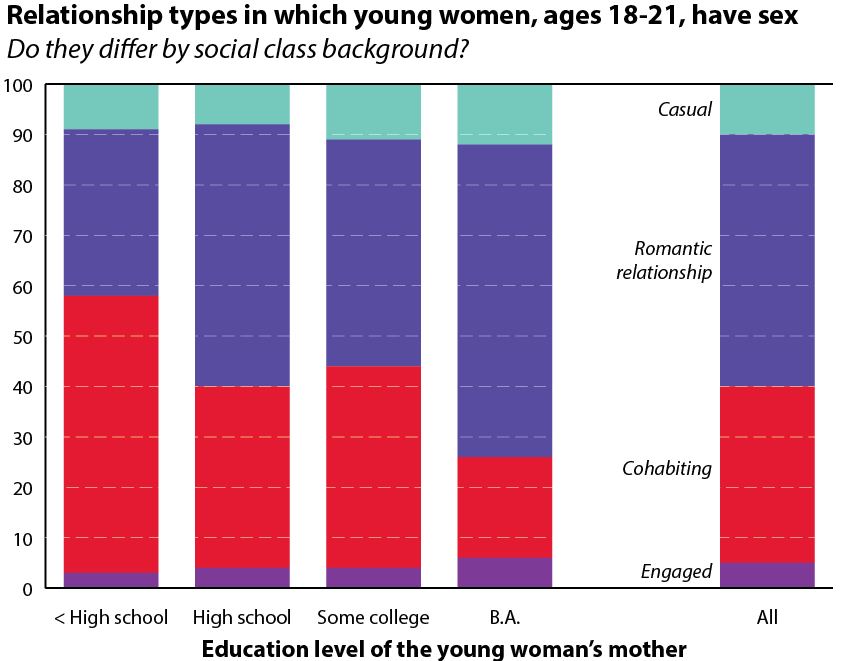Class and sex for young women
Welcome to our new research blog, “Sexuality and inequality research.” Our focus is on how sexuality is affected by various inequalities—class, gender, race, sexual orientation, and more. Our blog is a joint effort by 2014-15 ASA President Paula England, Professor of Sociology at New York University (pengland@nyu.edu), and four NYU doctoral students: Jonathan Marc Bearak, Mónica L. Caudillo, Jessie Ford, and Abigal Weitzman. The five of us have been working on analyses for the presidential address to be given at the 2015 annual meeting of the ASA in Chicago in August. We’ve discovered fascinating patterns, many of which won’t make it into the presidential address. We’ll share some of them with you in successive posts here on the Contexts site.
— Paula England
Jonathan Marc Bearak
Mónica L. Caudillo
Jessie Ford
Abigail Weitzman
Which young women have more casual sex, and which have sex in more serious relationships?
The college “hookup” culture involves youth, typically from middle class backgrounds, having casual sex. Young adults who are poor also have casual liaisons. But how common is casual sex compared to sex in exclusive relationships of varying levels of seriousness? And does it vary by social class?
We used a unique dataset collected by University of Michigan’s Jennifer Barber to estimate what percent of the sexual experiences young women have are casual, in romantic relationships, in cohabitations, or with partners to whom they are engaged. And we looked at how this varies by the young woman’s social class background—which we measure crudely by how much education her mother has. Barber’s study followed young women who were 18-19 years of age for 2.5 years between 2008 and 2010, checking in with them every week about their relationships. We examined all the weeks where the women had sex with someone but were not married, and looked to see what kind of relationships the sex took place in.
Here is what we found (the underlying numbers and how we got them are the table below):
- Most sex that women 18-21 years of age have is in relationships; overall only 10% of the time they had sex was with partners that they didn’t describe as an exclusive romantic relationship or someone they lived with or were engaged to.
- Women from more modest social class backgrounds are more likely to be cohabiting with their sexual partners; 55% of the time women whose mother hadn’t finished high school were cohabiting with their sexual partners, compared to 20% for women whose mothers finished college. This is mainly because women from poorer backgrounds start cohabiting much earlier.
 Note: “Engaged” means engaged to be married but not cohabiting. “Cohabiting” includes all women living with a male sexual partner, whether engaged or not. “Romantic” indicates that the woman reported that she and the partner had agreed to date only each other, but they were neither engaged nor cohabiting. “Casual” is all other sexual partnerships. Percents are regression-adjusted for race and age using multinomial logistic regression. N=17,612 person-weeks in which women were sexually active but not married; across 719 respondents. Data source: Relationship Dynamics and Social Life survey (Jennifer Barber, Principal Investigator, University of Michigan), a probability sample of young women from one county in Michigan who were 18-19 years of age at the baseline survey in 2008-09, and followed weekly for 2.5 years, until most were 20-21 years of age.
Note: “Engaged” means engaged to be married but not cohabiting. “Cohabiting” includes all women living with a male sexual partner, whether engaged or not. “Romantic” indicates that the woman reported that she and the partner had agreed to date only each other, but they were neither engaged nor cohabiting. “Casual” is all other sexual partnerships. Percents are regression-adjusted for race and age using multinomial logistic regression. N=17,612 person-weeks in which women were sexually active but not married; across 719 respondents. Data source: Relationship Dynamics and Social Life survey (Jennifer Barber, Principal Investigator, University of Michigan), a probability sample of young women from one county in Michigan who were 18-19 years of age at the baseline survey in 2008-09, and followed weekly for 2.5 years, until most were 20-21 years of age.
This post was updated on Dec. 10, 2014.


Comments 3
Mark Sherry
December 7, 2014Do you have data on disability?
Paula England
December 8, 2014Unfortunately, we don't.
Darryl H. Alvarez
November 14, 2019It was a libel format blog and inside it people have very well explained how sex is becoming commonplace in school colleges nowadays and it is causing a lot of harm to the generation going forward and blackjack game online free are available on this site . And in my opinion we have to stop it as soon as possible otherwise the results are not good.